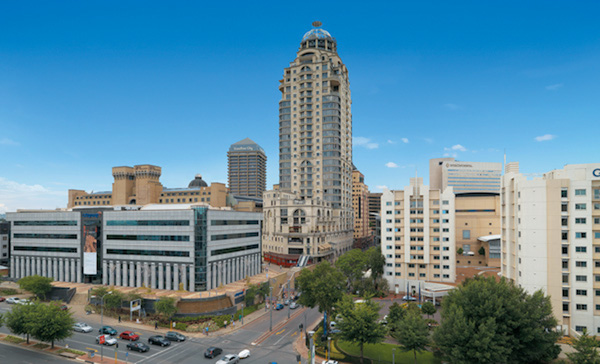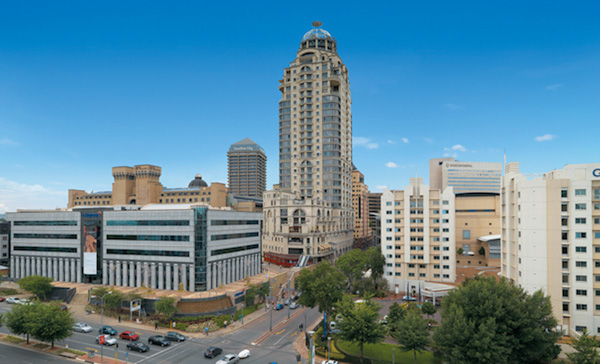South Africa – and Johannesburg – The Richest in Africa
 View of the Sandton central business district in northern Johannesburg, which has the largest square metreage of office space in South Africa. The nearby suburb of Sandhurst is home to the largest number of dollar millionaires on the continent. (Image: South African Tourism. Click for a larger view.)
View of the Sandton central business district in northern Johannesburg, which has the largest square metreage of office space in South Africa. The nearby suburb of Sandhurst is home to the largest number of dollar millionaires on the continent. (Image: South African Tourism. Click for a larger view.)Over the next year 262 000 square metres of new office space will come on line in Sandton, northern Johannesburg – more than three times the amount of space developed in 2012, and 61% of all new commercial construction in South Africa. Sandton is set to have the country’s largest concentration of office space, surpassing the southern Johannesburg CBD’s 166 700 square metres, and pushing Cape Town, with its 93 5208 square metres of office space, down to third.
All this construction will add more than 8 700 cars to the 19 500 driving into the Sandton area during the week. As odd as it may seem, the annoyance of daily traffic jams are a sign of a booming economy.
The cranes dotting Sandton’s skyline are a concrete reminder that South Africa remains the largest and strongest economy in Africa. According to a new report, Wealth Statistics in Africa (PDF), compiled by consultancy New World Wealth, the average South African is now worth $11 310, up from $4 200 in 2000. The consultancy puts this 169% rise in per capita wealth down to policies protecting asset ownership, a well-regulated banking system, and a free and independent media.
Security of investment
According to Andrew Amoils, a senior analyst at New World Wealth, while South Africa is still the strongest economy on the continent, this growth is slowing. For example, over the same period Angola grew by 737%. But investor security is what South Africa has over other African nations, Amoils said. “The right to own anything in South Africa is firm and this gives investors confidence and a will to buy anything from property to other assets in the country without worrying about ownership. Proper banking systems boosted investors’ confidence in the country and also promoted the circulation of cash.”
The New World Wealth study analysed trends in 19 African countries between 2000 and 2013. It used government statistics covering income distribution to determine per capita wealth. Primary residences were excluded in the study, but assets, investments and equities were counted. The research pegged the total value of individual wealth in South Africa at $571.2-billion last year – with most of it concentrated in the City of Johannesburg, of which Sandton forms part.
Starting with the discovery of gold in 1886, Johannesburg has grown into the economic engine of Africa. This “world class African city” (as the municipal slogan goes) of 4.4-million people lays claim to being the largest city not built on a near a major water source, and the world’s largest urban artificial forest. Johannesburg is now also home to the highest concentration of dollar millionaires in Africa.
There are now more than 23 000 high net worth individuals who call the city home (PDF) – and 285 are multimillionaires, defined as having net assets worth more than $30 million. On average he – and it is a man – is black and in his mid-50s. He lives in Sandhurst and his wealth is derived from black economic empowerment deals. He owns his multimillion-rand home and spends his money on art, classic cars and private jets.
The African list
Despite its impressive growth, Angola was just ninth on the Wealth Statistics in Africa list. Libya was second with $11 040 per capita and Namibia third at $10 500. Ethiopia, by the consultancy’s measure, was the poorest country in Africa, with wealth per person of only $260. Zimbabwe dropped the furthest on the list, down to just $570.
The global average is $27 600, but South Africa ranked healthily with its partners in the Brics grouping of major developing economies. Compared to South Africa’s $11 310, per capita wealth in Brazil is $20 000, in China it is $14 000, with India bringing up the rear at less than $2 000.
Growth to benefit all
An assessment by the World Bank in April 2013 found that African economies, except for South Africa, grew faster than the global average. The biggest challenge is to keep growth on track to raise the quality of life of all Africans, according to Makhtar Diop, World Bank vice president for Africa. “Without investment in electricity generation and higher agricultural productivity, Africa’s development future cannot prosper. The good news is that governments in Africa are intent on changing this.”
Angel Gurria, general secretary of the Organisation for Economic Cooperation and Development (OECD), makes the case that income equality remains the biggest challenge facing countries today, especially developing economies like South Africa. Higher growth rates have not translated to better living standards across income groups.
In South Africa’s Brics partner, Brazil, the earnings ratio between the richest 10% and the poorest is 27:1; the difference in South Africa is more than 100:1. “High levels of inequality generate high costs for society, dampening social mobility, undermining the labour market prospects of vulnerable social groups, and creating social unrest.”
Income inequality is one of the biggest challenges facing the country. The profound societal changes the country has undergone in 20 years have sharpened the inequality. But massive social grant and community development programmes have prevented the gap from widening further.
Government spending on health and education – 5.3% of GDP for education and 4.6% for health – has also helped to curb inequality. Research by the OECD has shown that spending on social programmes and improvements to healthcare and education go a long way to creating equal opportunities for all.
Economic expansion throughout Africa has seen the percentage of people living on less than $1.25 a day – the World Bank measure of poverty – fall to 48.5% from an estimated 58% between 1996 and 2013.
Gurria and the OECD have decided to take a holistic approach to measuring living standards. They have developed new, measurable dimensions on top of income and GDP to measure societal wellbeing.
“Life satisfaction, personal safety, and work-life balance matter as well. Social cohesion and inclusive growth are additional crucial perspectives to incorporate into public policies, targeting a renewed social contract that reduces inequalities and benefits the whole of society.”
Via : Mediaclubsouthafrica.com
Connect With Us
Related Posts
- Real Estate Act comes into effect: 10 things you need to know about new law ( May 4, 2017 )
- Expats Living in Comfort – Hyderabad, India ( May 4, 2017 )
- MNC queue to Hyderabad grows longer; JP Morgan & IBM look for office space ( June 22, 2016 )
- An Apple in Hyderabad’s IT Garden: CEO Tim Cook’s big announcement Today ( May 19, 2016 )
- Hyderabad May get Disneyland Park ( April 22, 2016 )
- Indian Office Space Absorption Up 11% in Q4: Survey ( April 13, 2016 )
- Cognizant plans to add 8,000 people at Hyderabad facility ( March 9, 2016 )
- Ranked 139 in world, Hyderabad is Best Indian City to Live in ( February 24, 2016 )
- The Platina – Exclusive Commercial Space, Hyderabad ( February 19, 2016 )
- Apple, Inc set to open new $25 million Tech Center in Hyderabad, India by June ( February 16, 2016 )
Recent Posts
Recent Comments
Archives
- February 2018
- October 2017
- May 2017
- June 2016
- May 2016
- April 2016
- March 2016
- February 2016
- January 2016
- December 2015
- November 2015
- October 2015
- July 2015
- June 2015
- May 2015
- April 2015
- March 2015
- February 2015
- December 2014
- November 2014
- October 2014
- September 2014
- August 2014
- July 2014
- June 2014
- May 2014
- April 2014
- March 2014
- February 2014
- January 2014
- December 2013
- November 2013
- October 2013
- September 2013
- August 2013
- July 2013
- June 2013
- May 2013
- April 2013
- March 2013
- February 2013
- January 2013
- December 2012
- November 2012
- October 2012
- September 2012
- August 2012
- July 2012
- June 2012
- May 2012
- April 2012
- March 2012
- February 2012
- January 2012
- December 2011
- November 2011
- October 2011
- September 2011
- July 2011
- June 2011
- May 2011
- March 2011
- November 2010
- October 2010
- September 2010
- August 2010
- July 2010
- May 2010
- April 2010
- March 2010
- February 2010



Leave a reply